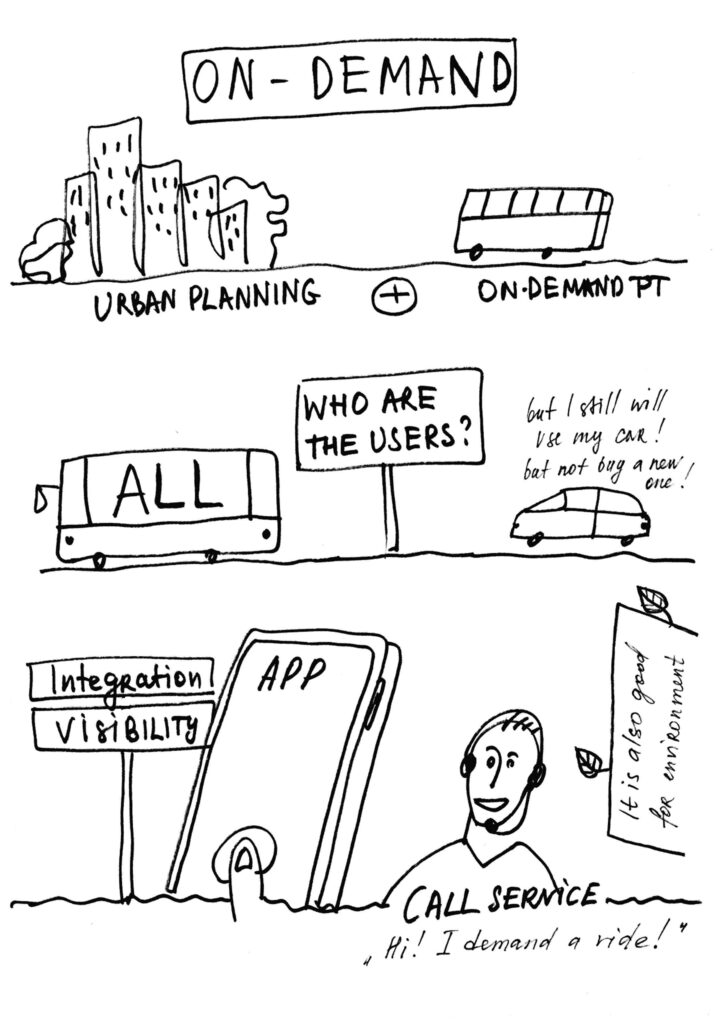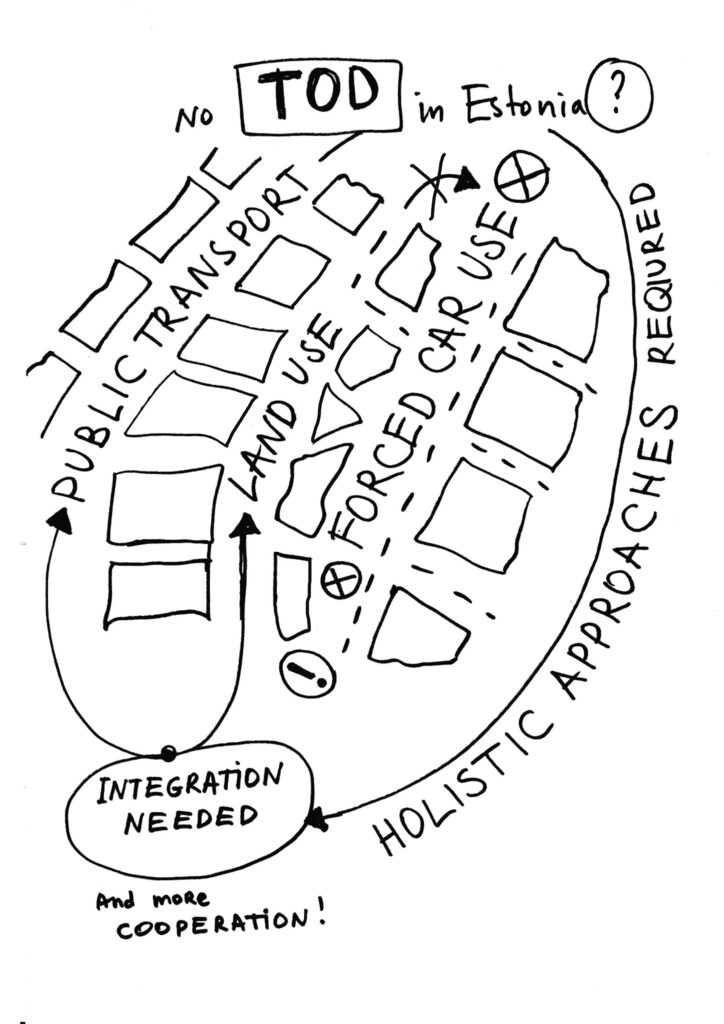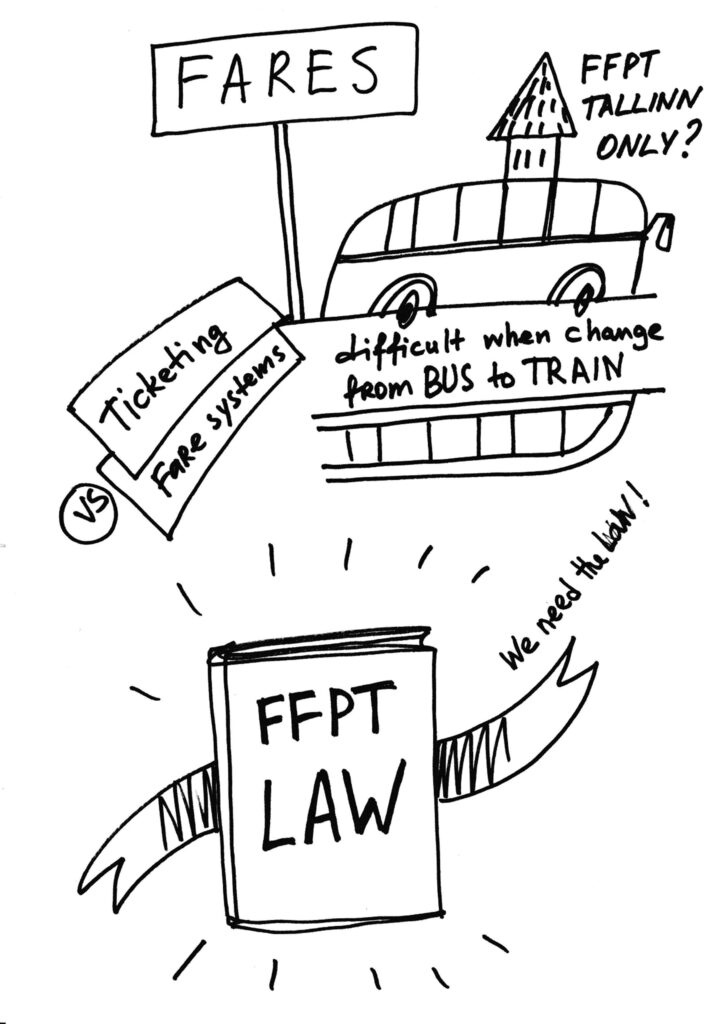On 27 April 2023 the event “Integrated Public Transport in Urban Regions” took place in Tallinn. The afternoon was dedicated to deepening the four central topics of the CARIN-PT project (demand-responsive transport (DRT); transport-oriented development (TOD); micro-mobility; transport pricing) and discussing them with local and international experts. In short presentations, the project partners from Belgium, Norway, Sweden and Estonia presented the theoretical framework, existing research and open questions.
Following the presentations, participants were invited to workshops where the respective topics were discussed based on local case studies and transregional issues as well as practical implications. The discussions revolved around the practicalities of Estonian public transport planning with relevant input and framing from international guests.
On-Demand or demand-responsive transport (DRT)
Marjolein Hantson, project researcher at Vrije Universiteit Brussel, presented a case study on demand-responsive transport in Flanders (Belgium) and invited participants to discuss the potential and limitations of DRT solutions in urban or rural areas. Participants discussed experiences with the BelBus system and the pilot project on the Estonian island of Saaremaa.
An initial consensus was that a well-functioning and integrated public transport network should link DRT services to central stations or transport hubs rather than duplicate the existing system. In this sense, considering the spatial dimension of DRT, public transport serves as a solution or band-aid for poor land use planning and facilitates connections towards remote areas.
As a functioning system such as Belbus in Belgium shows, integration relies equally on the existing public transport system and social transport, which includes transport of pupils, the elderly or the impaired. This illustrates the political focus of DRT, which serves social equity objectives in public transport rather than environmental sustainability measures.

In terms of creating more equitable and integrated transport systems, it is important to remember that on-demand systems should not serve as an incentive for low-density living, but rather as a way to solve mobility constraints for those in need. While on-demand systems are a valuable addition for people excluded from access to existing public transport, new developments should focus more on transit-oriented planning and development.
Illustration of the discussion on on-demand transport by Aleksandra Ianchenko
Transit-Oriented Development (TOD)
Transit-oriented Development (TOD) was discussed with participants of the workshop led by Tanu Priya Uteng, Senior Research Planner at the TOI Institute of Transport Economics in Oslo. Participants noted that there are currently no approaches to TOD in the Estonian context, as there are no integrated approaches to land use and transport. This is partly due to the fragmentation of authorities at the administrative level and between local, regional and state levels.
The absence of TOD may result in a range of urban problems. The lack of access to public transport and the absence of regional cohesion in transport planning lead to a compulsion for car ownership and thus explain the high level of motorisation, especially in rural or peri-urban areas. Moreover, real estate and urban developers have the upper hand in land use design, and there is no clause requiring developers to integrate transport access or planning. This leads potentially to transport poverty and related social exclusion. Respondents criticize an overall lack of cooperation between transport and land-use planners.

In addition, participants discussed various prerequisites for promoting TOD, for example – but not exclusively – in the Estonian context. First, there is a need for empirically based evidence or supporting studies that show the pace of densification and the economic benefits of TOD. Second, a methodological toolbox with theoretical foundations, best practice examples and practical guidelines for developing TOD policies would support the decision-making processes of interested practitioners, planners and policymakers.
Illustration of the discussion on transit-oriented development by Aleksandra Ianchenko
Micro-Mobility (MM)
Chiara Vitrano, researcher at the Swedish National Institute for Road and Transport Research (VTI, led a table discussion on micro-mobility (MM), which involves various modes of human-powered and electric transport, different actors involved (public, private and PPP) and various regulatory frameworks.
The discussants identified three barriers that occur in the Estonian context. Firstly, there is a lack of integration between MM and public transport (e.g. difficulty of parking scooters at stations or taking bicycles on buses) and a lack of integrated payment methods. A second obstacle is found in the infrastructure in place (e.g. absence of separate lanes or areas for diverse modes of mobility) and related safety concerns. Micro-mobility, particularly e-scooters, is often discussed in relation to safety concerns for the riders as well as for other participants in traffic and public spaces. Yet, discussants pointed out that safety can be measured in different ways, e.g. perception of safety or frequency of injury, and the danger of e-scooters is often overstated. The third obstacle discussed was that it is at the individual level, i.e. the power of habits, as potential MM users rely on their own motivation to change mobility habits and break away from ingrained ways of getting around.

The discussants concluded that while MM could be a valuable complement to public transport, especially in sparsely populated areas, there are important trade-offs to consider: MM could improve accessibility for some, but if this is done at the expense of reducing public transport services overall, it would reduce accessibility for those who cannot use MM services. Thus, an inclusive and just public transport system would be complemented by MM but needs to be sufficiently accessible and available for those who cannot or do not want to use it.
Illustration of the discussion on micro-mobility transport by Aleksandra Ianchenko
Fares and fairness
In conversation with Õnne Kask, researcher at Tallinn University, and Karel Martens, professor of transport planning at the Israel Institute of Technology, participants of the workshop discussed the integration and fairness of transport fares. An integrated fare and ticketing system would provide all citizens with a sufficient offer of public transport and facilitate the use of public transport.
Discussants agree that within the Tallinn City Region and Harjumaa County, the problem lies not in the technical integration of ticketing, as there is the possibility to pay for different services with a unified ticketing and payment system, but rather in the integration of fares. This means that passengers have to pay various fares depending on the zone or mode of transport, which can significantly increase the cost of intermodal transfers within the region. However, as several participants note, passengers do not mainly seem to be concerned about the fares, but rather about comfort, time, network connectivity and other passengers who are perceived as unfriendly or annoying.
Nevertheless, the lack of fare integration and financing policies poses an obstacle for involved municipalities, planners and operators. The main difficulty appears to lie in the administrative and political hurdles, i.e. the city administration not willing to integrate a system with surrounding municipalities and the region being exploited by various operators. Especially the municipalities bordering Tallinn suffer from providing services to residents who pay taxes in Tallinn.

Workshop participants agree that public transport is only one element within a wider question of public service delivery and that the integration or redistribution of tax systems and fares is only one part of the public transport problem. In general, there seems to be a lack of regional coordination and a central, overarching authority to regulate public transport services, revenues and fares. The discussants call for a more proactive role of the state or an overarching administrative body and for a law that makes the authority responsible for the coordination and integration of the different transport operators.
Illustration of the discussion on transport pricing by Aleksandra Ianchenko
In the exchange with the various participants of the workshops, the four CARIN-PT teams received valuable input for their projects, which are to be further developed into locally embedded Urban Living Labs. Make sure to subscribe to our newsletter to stay informed about further project activities and think along on our further process.


